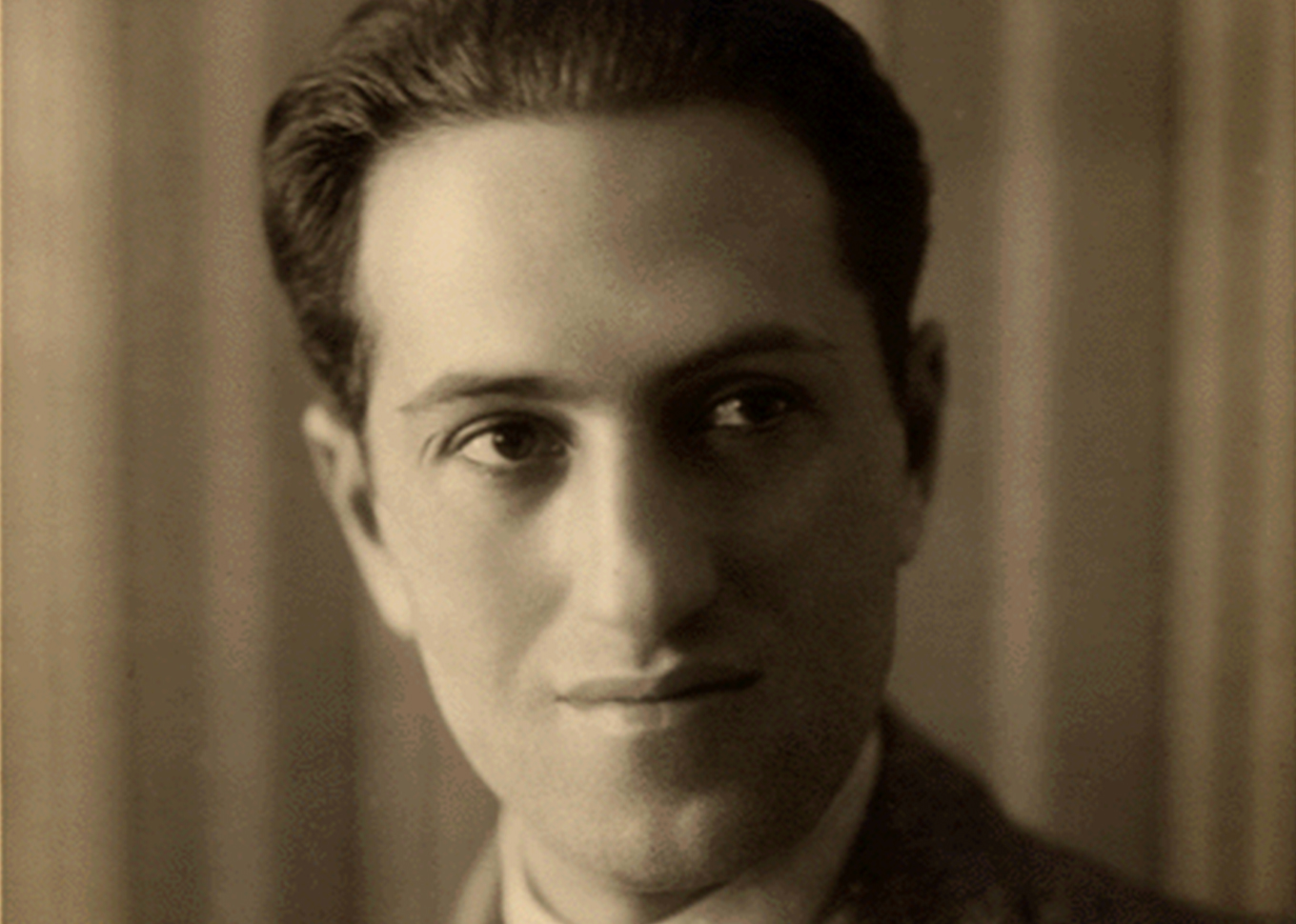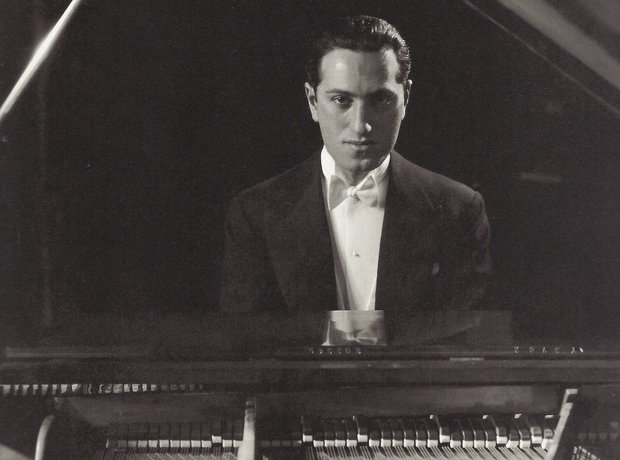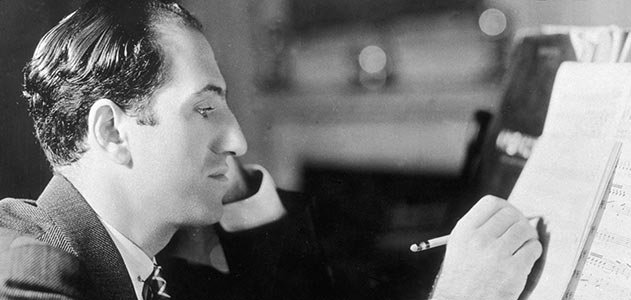George Gershwin

George Gershwin was one of the most significant and popular American composers of all time. Born in Brooklyn, New York in 1898, he wrote primarily for the Broadway musical theatre, but important as well are his orchestral and piano compositions in which he blended, in varying degrees, the techniques and forms of classical music with the stylistic nuances and techniques of popular music and jazz.
Early career and influences
Gershwin was the son of Russian-Jewish immigrants. Although his family and friends were not musically inclined, Gershwin developed an early interest in music through his exposure to the popular and classical compositions he heard at school and in penny arcades. He began his musical education at age 11, when his family bought a second-hand upright piano, ostensibly so that George’s older sibling, Ira, could learn the instrument. When George surprised everyone with his fluid playing of a popular song, which he had taught himself by following the keys on a neighbor’s player piano, his parents decided that George would be the family member to receive lessons. He studied piano with the noted instructor Charles Hambitzer, who introduced his young student to the works of the great classical composers. Hambitzer was so impressed with Gershwin’s potential that he refused payment for the lessons; as he wrote in a letter to his sister, “I have a new pupil who will make his mark if anybody will. The boy is a genius…”
Gershwin continued to broaden his musical knowledge and compositional technique throughout his career with such disparate mentors as the idiosyncratic American composers Henry Cowell and Wallingford Riegger, the distinguished traditionalist Edward Kilenyi, and Joseph Schillinger, a musical theorist known for his mathematically grounded approach to composition. After dropping out of school at age 15, Gershwin earned an income by making piano rolls for player pianos and by playing in New York nightclubs. His most important job in this period was his stint as a song plugger (probably the youngest in Tin Pan Alley), demonstrating sheet music for the Jerome Remick music-publishing company. In an era when sheet-music sales determined the popularity of a song, song pluggers such as Gershwin worked long hours pounding out tunes on the piano for potential customers. Although Gershwin’s burgeoning creativity was hampered by his three-year stint in “plugger’s purgatory” (as Gershwin biographer Isaac Goldberg termed it), it was nevertheless an experience that greatly improved his dexterity and increased his skills at improvisation and transposing. While still in his teens, Gershwin was known as one of the most talented pianists in the New York area and worked as an accompanist for popular singers and as a rehearsal pianist for Broadway musicals. In 1916 he composed his first published song, “"When You Want ’Em You Can’t Get ’Em (When You’ve Got ’Em You Don’t Want ’Em),"” as well as his first solo piano composition, “"Rialto Ripples."” He began to attract the attention of some Broadway luminaries, and the operetta composer Sigmund Romberg included one of Gershwin’s songs in The Passing Show of 1916.
These early experiences greatly increased Gershwin’s knowledge of jazz and popular music. He enjoyed especially the songs of Irving Berlin and Jerome Kern—referring to Berlin as “America’s Franz Schubert” and stating that Kern was “the first composer who made me conscious that most popular music was of inferior quality, and that musical comedy was made of better material”—and he was inspired by their work to compose for the Broadway stage. In 1919 entertainer Al Jolson performed the Gershwin song “"Swanee"” in the musical Sinbad; it became an enormous success, selling more than two million recordings and a million copies of sheet music, and making Gershwin an overnight celebrity. That same year, La, La Lucille, the first show for which Gershwin composed the entire score, premiered; its most popular songs included “"The Best of Everything,"” “"Nobody but You,"” and “"Tee-Oodle-Um-Bum-Bo."” Also in 1919, Gershwin composed his first “serious” work, the Lullaby for string quartet. A study in harmony that Gershwin composed as an exercise for Kilenyi, Lullaby’s delicate beauty transcends its academic origins. Ira Gershwin published the work several years after George’s death, and it has gone on to become a favourite with string quartets and with symphony orchestras, for which it was subsequently scored.

Rhapsody in Blue
During the next few years, Gershwin contributed songs to various Broadway shows and revues. From 1920 to 1924 he composed scores for the annual productions of George White’s Scandals, the popular variety revue, producing such standards as “"(I’ll Build a) Stairway to Paradise"” and “"Somebody Loves Me."” For the Scandals production of 1922, Gershwin convinced producer White to incorporate a one-act jazz opera. This work, Blue Monday (later reworked and retitled as 135th Street), was poorly received and was removed from the show after one performance. Bandleader Paul Whiteman, who had conducted the pit orchestra for the show, was nevertheless impressed by the piece. He and Gershwin shared the common goal of bringing respectability to jazz music, which in 1922 was still being regarded, as evidenced in a New York American editorial, as “degrading, pathological, nerve-irritating, sex-exciting music.” To this end, in late 1923 Whiteman asked Gershwin to compose a piece for an upcoming concert—entitled “An Experiment in Modern Music”—at New York’s Aeolian Concert Hall. Legend has it that Gershwin forgot about the request until early January 1924, when he read a newspaper article announcing that the Whiteman concert on February 12 would feature a major new Gershwin composition. Writing at a furious pace in order to meet the deadline, Gershwin composed Rhapsody in Blue, perhaps his best-known work, in three weeks’ time.
Owing to the haste in which it was written, Rhapsody in Blue was somewhat unfinished at its premiere. Gershwin improvised much of the piano solo during the performance, and conductor Whiteman had to rely on a nod from Gershwin to cue the orchestra at the end of the solo. Nevertheless, the piece was a resounding success and brought Gershwin worldwide fame. The revolutionary work incorporated trademarks of the jazz idiom (blue notes, syncopated rhythms, onomatopoeic instrumental effects) into a symphonic context. Gershwin himself later reflected on the work:
The work, arranged by Ferde Grofé (composer of the Grand Canyon Suite) for either symphony orchestra or jazz band, is perhaps the most-performed and most-recorded orchestral composition of the 20th century. It is the only one of Gershwin’s major works that Gershwin himself did not orchestrate.

Popular Songs
For the remainder of his career, Gershwin devoted himself to both popular songs and orchestral compositions. His Broadway shows from the 1920s and ’30s featured numerous songs that became standards: “"Fascinating Rhythm,"” “"Oh, Lady Be Good,"” “"Sweet and Low-Down,"” “"Do, Do, Do,"” “"Someone to Watch over Me,"” “"Strike Up the Band,"” “"The Man I Love,"” “"’S Wonderful,"” “"I’ve Got a Crush on You,"” “"Bidin’ My Time,"” “"Embraceable You,"” “"But Not for Me,"” “"Of Thee I Sing,"” and “"Isn’t It a Pity."” He also composed several songs for Hollywood films, such as “"Let’s Call the Whole Thing Off,"” “"They All Laughed,"” “"They Can’t Take That Away from Me,"” “"A Foggy Day,"” “"Nice Work if You Can Get It,"” “"Love Walked In,"” and “"Love Is Here to Stay."” His lyricist for nearly all of these tunes was his older brother, Ira, whose glib, witty lyrics—often punctuated with slang, puns, and wordplay—received nearly as much acclaim as George’s compositions. The Gershwin brothers comprised a somewhat unique songwriting partnership in that George’s melodies usually came first—a reverse of the process employed by most composing teams. (When asked by interviewers, “Which comes first, the words or the music?”, Ira’s standard response was, “The contract.”) So facile was George’s musical imagination that quality songs were often composed within a few minutes of improvisation; other times, he dipped into his notebooks of song sketches that he accumulated over time (he once said, “I have more tunes in my head than I could put down on paper in a hundred years”) and embellished an old melody he had labeled “g.t.” (for “good tune”). Ira would then spend a week or more fitting words to the tune, polishing each line (to the extent that he was nicknamed “The Jeweller” by other songwriters) until he was satisfied. Songwriter Arthur Schwartz regarded Ira’s efforts to be “a truly phenomenal feat, when one considers he was required to be brilliant within the most confining rhythms and accents.”
One of the Gershwins’ best-known collaborations, “"I Got Rhythm,"” was introduced by Ethel Merman in the musical Girl Crazy (1930). The following year, Gershwin scored a lengthy, elaborate piano arrangement of the song, and in late 1933 he arranged the piece into a set of variations for piano and orchestra; “I Got Rhythm” Variations has since become one of Gershwin’s most-performed orchestral works. In addition, the 32-bar structure of “"I Got Rhythm"” has become the second-most frequently used harmonic progression in jazz improvisation, next to that of the traditional 12-bar blues.
Gershwin’s piano score for “"I Got Rhythm"” was part of a larger project begun in 1931, George Gershwin’s Songbook. A collection of Gershwin’s personal favourites among his many hit tunes, it featured the composer’s own adaptations designed “for the above-average pianist.” Offering valuable insight into Gershwin’s use of rhythm and harmony, as well as his own piano style, the Songbook selections have become concert staples for several noted pianists throughout the years and have occasionally been adapted into full orchestra arrangements.

Porgy and Bess
Throughout his career, Gershwin had major successes on Broadway with shows such as Lady, Be Good! (1924), Oh, Kay! (1926), Strike Up the Band (1930), Girl Crazy (1930), and, especially, the daring political satire Of Thee I Sing (1931), for which Ira and librettists George S. Kaufman and Morrie Ryskind shared a Pulitzer Prize. (Rules of the Pulitzer committee at the time did not allow for composers to share in a drama award. Ira objected that George was not a corecipient, but George insisted that the rules be obeyed. In protest, Ira hung his Pulitzer certificate in his bathroom.) These shows, smash hits in their time, are (save for Gershwin’s music) largely forgotten today; ironically, his most enduring and respected Broadway work, Porgy and Bess, was lukewarmly received upon its premiere in 1935. Gershwin’s “American Folk Opera” was inspired by the DuBose Heyward novel Porgy (1925) and featured a libretto and lyrics by Ira and the husband-wife team of DuBose and Dorothy Heyward. In preparation for the show, Gershwin spent time in the rural South, studying firsthand the music and lifestyle of impoverished African Americans. Theatre critics received the premiere production enthusiastically, but highbrow music critics were derisive, distressed that “lowly” popular music should be incorporated into an opera structure. Black audiences throughout the years have criticized the work for its condescending depiction of stereotyped characters and for Gershwin’s inauthentic appropriation of black musical forms. Nevertheless, Gershwin’s music—including such standards as “"Summertime,"” “"It Ain’t Necessarily So,"” “"Bess, You Is My Woman Now,"” and “"I Got Plenty O’ Nuttin’"”—transcended early criticism to attain a revered niche in the musical world, largely because it successfully amalgamates various musical cultures to evoke something uniquely American and wholly Gershwin. Porgy and Bess received overdue recognition in the years 1952–54 when the U.S. State Department selected it to represent the United States on an international tour, during which it became the first opera by an American composer to be performed at the La Scala opera house in Milan. While it still raises political issues, contemporary attitudes towards the work are reflected in a statement by Grace Bumbry, who portrayed Bess in the Metropolitan Opera’s widely praised revival in 1985: “I resented the role at first, possibly because I really didn’t know the score, and I think because of the racial aspect. I thought it beneath me, I felt I had worked far too hard, that we had come too far to regress to 1935. My way of dealing with it was to see that it really was a piece of Americana, of American history.” Many now consider the score from Porgy and Bess to be Gershwin’s greatest masterpiece.
As the noted musicologist Hans Keller stated, “Gershwin is a genius, in fact, whose style hides the wealth and complexity of his invention. There are indeed weak spots, but who cares about them when there is greatness?”





 © 2021-2022 Gershwin International Music Competition.
© 2021-2022 Gershwin International Music Competition.